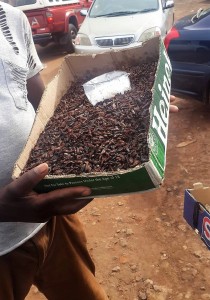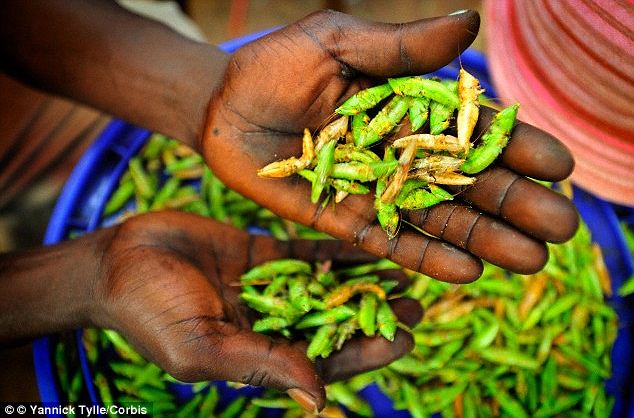Malawi is facing a food security crisis with 6.7 million people in urgent need of support to keep them until the next harvest in March, 2017. There is no humour in this. Yet in June 2016, the president of the nation jokingly suggested that Malawians eat grasshoppers, among other things, to curb their hunger. The outrage and displeasure from Malawians was tremendous. The taste of the joke is for anyone to judge and so I will not delve into its appropriateness. Rather, I would like to briefly explore the insect consumption in Malawi, its benefits and the feasibility of insects as an alternative food source in Malawi.
The responses from the president’s office following the outrage, ranged from “misunderstood words” to “these foods are delicacies”. They are. Delicacies. The fact is, Malawians have been eating grasshoppers and other insects for generations. While eating insects is coming up in North America and Europe, as an alternative protein source that is more environmentally and cost efficient, in most of the world insect consumption is nothing new. Entomophagy; eating insects, has been practiced in South America, Asia, Australia, Africa and particularly Malawi for generations and is not a dead practice.
Insects are eaten as a snack or relish, a part of a meal and not a meal in itself. The earliest record of entomophagy in Malawi was by ethnobiologist Jessie Williamson in 1938 who recorded over twenty species eaten in only two out of Malawi’s 28 districts. Brian Morris’s book “Insects and Human Life” (2004) has a more in-depth account of the insects eaten across Malawi, their collection and preparation for consumption and market. The most commonly eaten insects in Malawi are flying termites (ants), caterpillars and grasshoppers. Insects are low-cost, high in nutrients and are also a source of income. Despite this, the only insects currently in the limelight in Malawi for their livelihood benefits are bees.
Malawi is currently going through extreme hunger on the back of an El Nino caused drought. This has caused high crop failure of the staple crop, maize. After stating that the government is doing all it can the president asked “But why should Malawian die with hunger when we have different things to eat? Muzidya mbewa, zitete, komanso chinangwa!” This last part translates to: You should eat field mice, grasshoppers and cassava. Alternatives. Cassava instead of maize and, grasshoppers and mice instead of meat, poultry and fish as relish. An acceptable suggestion really, as in some parts of the north cassava is the staple starch while grasshoppers are considered a delicacy in most of the country.
I expect a little surprise at these suggestions where the food is not native but, not in Malawi given the brief history above. Westernization? Second rate food? All these came to mind as reasons for the outrage.
I asked a friend to send me a picture of flying ants for sale if she happened to travel between cities in the coming days. They are in season and are common on the road side. She sent me the picture to the right after 2 hours. They were being sold at the market in the Capital city. And I recalled they are sold in the markets. Along with caterpillars and grasshoppers, in both urban and rural areas. Malawians still eat these at all levels of income. So why the outrage? Was it more of: How could the president say that when he is probably spoiled for choice?
How?
Possibly because it is a viable alternative. Cassava and potatoes are being encouraged as alternatives to maize by the government and various agencies in Malawi. For Malawi there is always a focus on starch. But with the malnutrition in the country, why can’t insects be promoted as well? As alternatives to meat and fish which are quite expensive for the average Malawian even in times of plenty.
They do make sense. Though the prospect of producing them seems daunting.
What guidelines should be followed?
Who will provide start-up cost?
How much land is needed to farm insects?
How much water?
How will they be preserved, packaged and delivered to customers?
However, it has been done. Thailand has been praised by the Food and Agriculture Organisation(FAO) for its viable and thriving insect farming. Closer to Malawi FAO is working on a project the Democratic Republic of Congo to promote farming of edible insects. From individual efforts in Thailand that involved months of trial and error, to those with more partners and beneficiaries like the 7-year insect farming project in the DRC, and growing farms in Europe, insect farming is being done. While there are no widely accepted guidelines, cases like these can provide a starting point.

Some insects are seasonal. Termites are found in the early rainy season in November. A general time of hunger when the last harvest is running low and people are preparing to plant. While they can be salted and dried they do not keep long and cannot be kept as food for the year in this form of preservation. Mopane worms, commonly eaten in Botswana, Zimbabwe, Zambia, South Africa and Namibia are available canned. A project in Namibia is doing this, an option to beat seasonality.
Presented as a joke is something to be seriously considered in terms of food security for Malawi. But how can I or you suggest a poor farmer eat insects while we have options and can make choices? It is indeed a viable alternative but what of food justice and sovereignty in the face of hunger? This baffles me and I have yet to find an answer even remotely suitable. At present though, I can say insects can be like meat in the rural areas. It is a joy when they are in season. A joy to eat and a joy to sell. In this case they are an option in a time of strife. So while it riles me, I ponder the soundness of saying, let them eat grasshoppers.


Interesting article indeed.
LikeLike